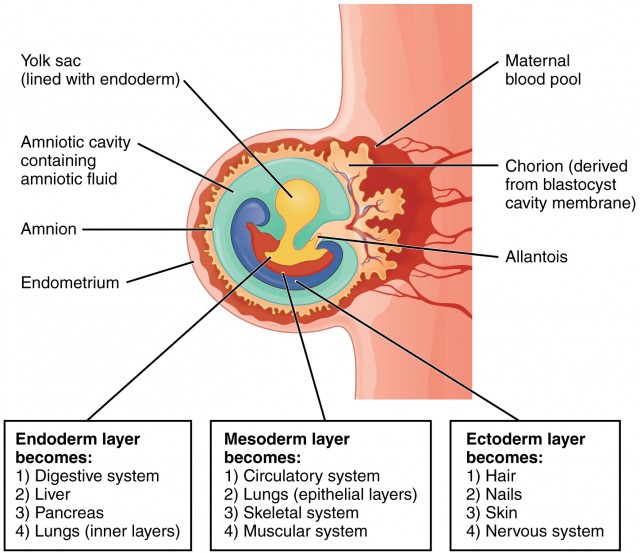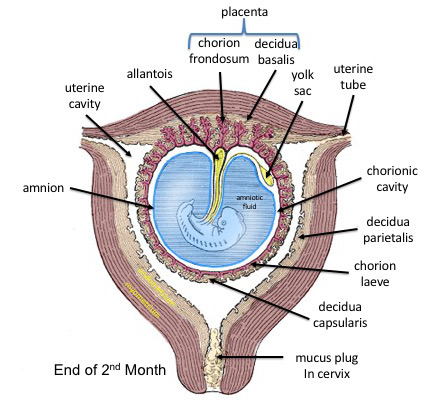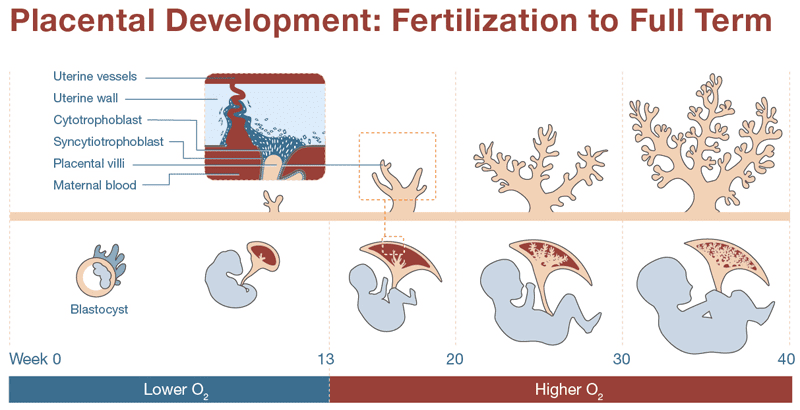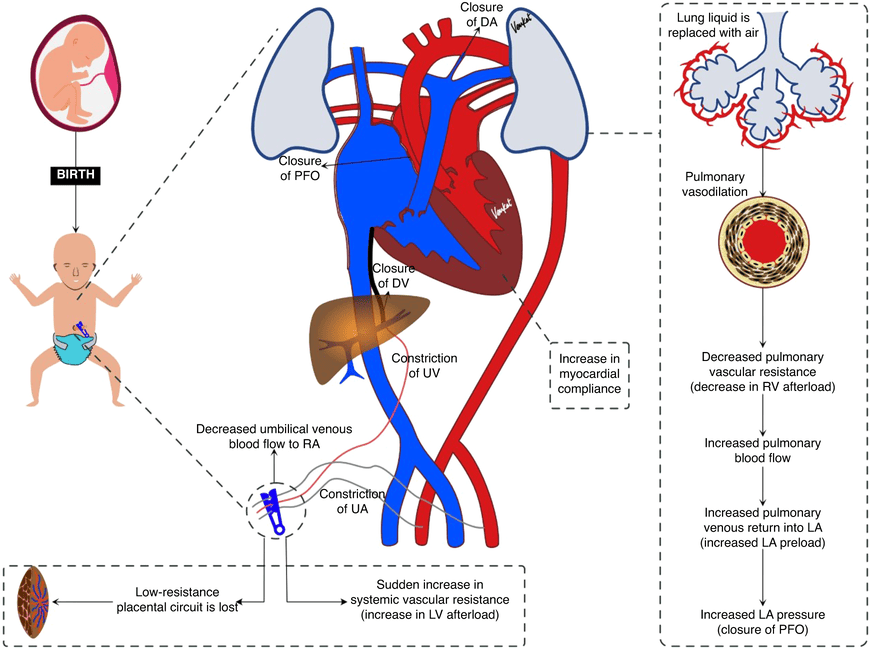Fetal Membranes, Placenta, Cord and Circulation: Safety and Feeding

The Fetal Membranes and Placenta
The fetal membranes and the placenta are temporary, yet essential, organs that develop alongside the embryo and fetus. They provide a complete life-support system, handling protection, nourishment, gas exchange, waste removal, and hormonal regulation critical for successful intrauterine development. They are expelled from the body after birth.

The Four Primary Fetal Membranes
There are four extraembryonic membranes that form the supportive environment for the embryo.
1. The Amnion
Formation & Structure:
A thin, tough membrane that separates from the epiblast during the 2nd week to form the amniotic cavity. It eventually expands to engulf the entire embryo, filling the chorionic cavity and fusing with the chorion.
Key Functions:
- Forms the Amniotic Sac: A fluid-filled sac that surrounds and cushions the fetus.
- Protection & Stability: The amniotic fluid acts as a shock absorber and maintains a stable temperature.
- Development: Allows for free fetal movement (essential for musculoskeletal growth) and fetal "breathing" of the fluid (crucial for lung maturation).
2. The Yolk Sac
Formation & Structure:
Forms from the hypoblast layer during the 2nd week and is connected to the embryonic midgut. In humans, it is relatively small and regresses as development proceeds.
Key Functions (Early Development):
- Early Nutrient Transfer: Provides primary nutrients before the placenta is fully functional.
- Hematopoiesis: The first site of blood cell formation in the embryo (around week 3).
- Primordial Germ Cell Origin: The precursors to sperm and eggs originate in its walls.
Fate:
It is eventually incorporated into the umbilical cord and degenerates by the end of the first trimester.
3. The Allantois
Formation & Structure:
A small, finger-like outpouching from the wall of the yolk sac that appears during the 3rd week. It is largely vestigial in humans.
Key Functions (Early Development):
- Blood Vessel Formation: Its mesodermal wall contributes to the formation of the umbilical arteries and veins.
- Bladder Development: Its proximal part is incorporated into the developing urinary bladder.
Fate:
Its remnant forms the urachus, which becomes the median umbilical ligament in adults.
4. The Chorion
Formation & Structure:
The outermost fetal membrane, formed by the trophoblast and the extraembryonic mesoderm. It develops finger-like projections called chorionic villi that invade the endometrium.
Key Functions:
- Forms the Fetal Placenta: The part with abundant villi (the chorion frondosum) becomes the fetal component of the placenta.
- Encloses Other Membranes: Surrounds the amnion, yolk sac, and allantois.
- Protective Barrier: Contributes to the barrier between maternal and fetal blood.


The Placenta
The placenta is a composite, temporary organ formed by both fetal tissues (the chorionic villi) and maternal tissues (the decidua basalis of the endometrium). It serves as the complete life-support system for the fetus and is also a critical endocrine organ during pregnancy.
A. Development of the Placenta
The placenta begins to form as soon as the blastocyst implants, with the trophoblast rapidly differentiating and invading the uterine wall.
Chorionic Villi Formation
The fetal portion of the placenta develops through three stages of villi:
- Primary Villi: Columns of cytotrophoblast penetrate the syncytiotrophoblast.
- Secondary Villi: Mesenchyme (connective tissue) invades the core of the primary villi.
- Tertiary Villi: Fetal blood vessels develop within the mesenchymal core, establishing the feto-placental circulation.
B. Functions of the Placenta
The placenta is a multi-functional powerhouse, acting as the fetus's lungs, kidneys, GI tract, and endocrine gland.
Metabolic Functions
Synthesizes glycogen, fatty acids, and cholesterol, and actively transports essential nutrients like glucose, amino acids, and vitamins from mother to fetus.
Gas Exchange
Transfers oxygen from maternal blood to fetal blood and transfers carbon dioxide from fetal blood to maternal blood, acting as the fetal lungs.
Waste Removal
Excretes fetal metabolic waste products (urea, uric acid, creatinine) into the maternal bloodstream for disposal by the mother's kidneys.
Hormone Production
- hCG: Maintains the corpus luteum in early pregnancy.
- Progesterone: Maintains the pregnancy and keeps the uterus relaxed.
- Estrogens: Promote uterine and mammary gland growth.
- hPL: Modifies maternal metabolism to support fetal energy needs.
Immunological Barrier
Allows passive immunity by transferring maternal antibodies (IgG) to the fetus. It also acts as a partial barrier, though many harmful substances (drugs, viruses, alcohol) can cross it.

C. The Placental Barrier
This is not a true barrier but rather a highly selective membrane across which all exchange occurs. It consists of four layers initially, which thin out as pregnancy progresses to increase efficiency:
- Syncytiotrophoblast
- Cytotrophoblast (thins out later)
- Connective tissue of the villus core
- Endothelium of the fetal capillaries

The Umbilical Cord: The Fetal Lifeline
The umbilical cord develops from the connecting stalk and serves as the vital connection between the fetus and the placenta, facilitating all exchange.
Two Umbilical Arteries
Carry deoxygenated blood and waste from the fetus to the placenta.
One Umbilical Vein
Carries oxygenated blood and nutrients from the placenta to the fetus.
Wharton's Jelly
A gelatinous connective tissue that surrounds and protects the vessels from compression.

Fetal Circulation
In utero, the fetus relies entirely on the placenta for respiration, nutrition, and excretion, as its lungs and GI tract are non-functional. Fetal circulation is ingeniously designed with a series of shunts to accommodate this reality, ensuring the most highly oxygenated blood reaches the most critical organs.
The Pathway of Fetal Blood Flow
Summary & Mnemonic
A simple way to remember the key structures in order:
P-U-D-I-F-D-U
(Placenta → Umbilical Vein → Ductus Venosus → IVC → Foramen Ovale → Ductus Arteriosus → Umbilical Arteries)

Changes After Birth: Adaptation to Extrauterine Life
At birth, with the first breath and the clamping of the umbilical cord, a series of rapid and profound physiological changes occur to transition the circulatory system from fetal to adult patterns.
Closure of Fetal Shunts
The onset of respiration increases pressure in the left atrium, closing the flap-like foramen ovale. Increased oxygen levels and changes in prostaglandins cause the muscular walls of the ductus arteriosus and ductus venosus to constrict and close.
Formation of Ligaments (Remnants)
- Umbilical Vein → Ligamentum Teres (in the falciform ligament of the liver).
- Ductus Venosus → Ligamentum Venosum.
- Foramen Ovale → Fossa Ovalis.
- Ductus Arteriosus → Ligamentum Arteriosum.
- Umbilical Arteries → Medial Umbilical Ligaments.
Test Your Knowledge
Check your understanding of the concepts covered in this post.
1. Which fetal membrane directly surrounds the embryo/fetus and is filled with amniotic fluid?
- Chorion
- Yolk sac
- Amnion
- Allantois
2. The primary function of amniotic fluid includes all of the following EXCEPT:
- Cushioning the fetus from trauma
- Providing nutrients for fetal growth
- Allowing for fetal movement
- Maintaining fetal body temperature
3. The placenta is formed from tissues derived from both the mother and the fetus. Which fetal component primarily contributes to the formation of the placenta?
- Amnion
- Yolk sac
- Trophoblast
- Inner cell mass
4. Which part of the placenta is the site of nutrient, gas, and waste exchange between mother and fetus?
- Decidua basalis
- Chorionic villi
- Amniotic sac
- Umbilical vein
5. The umbilical cord typically contains how many blood vessels?
- One artery, one vein
- Two arteries, one vein
- One artery, two veins
- Two arteries, two veins
6. Which of the following fetal shunts bypasses the liver, directing oxygenated blood from the umbilical vein directly to the inferior vena cava?
- Foramen ovale
- Ductus arteriosus
- Ductus venosus
- Patent foramen ovale
7. In fetal circulation, the highest oxygen saturation is found in the blood within the:
- Umbilical arteries
- Pulmonary artery
- Umbilical vein
- Aorta
8. The foramen ovale is a shunt that allows blood to bypass which fetal organ?
- Liver
- Lungs
- Kidneys
- Brain
9. What is the primary reason why fetal lungs receive only a small amount of blood flow in utero?
- They are not yet fully developed.
- The fetus breathes amniotic fluid.
- High pulmonary vascular resistance.
- The lungs are filled with meconium.
10. After birth, the ductus arteriosus typically closes to become the:
- Ligamentum teres
- Ligamentum venosum
- Ligamentum arteriosum
- Medial umbilical ligaments
11. The fetal component of the placenta, characterized by its finger-like projections, is called the _____________.
12. The gelatinous substance that surrounds the blood vessels within the umbilical cord, protecting them from compression, is known as _____________.
13. The fetal shunt that connects the pulmonary artery to the aorta, bypassing the fetal lungs, is the _____________.
14. The part of the maternal endometrium that forms the maternal portion of the placenta is the _____________.
15. The small, usually non-functional, sac that extends from the embryonic gut into the connecting stalk, contributing to early blood formation and primordial germ cell migration, is the _____________.
Quiz Complete!
Your Score:
0%
0 / 0 correct